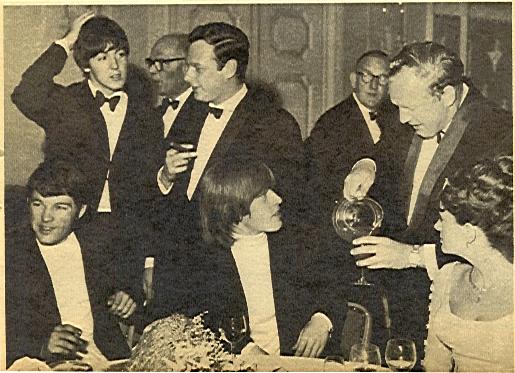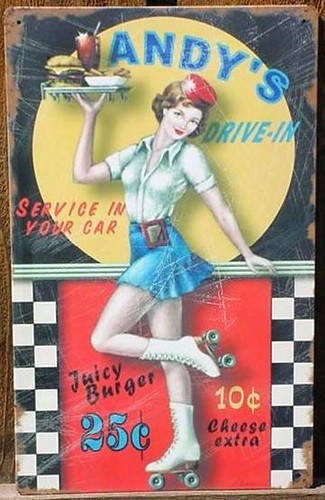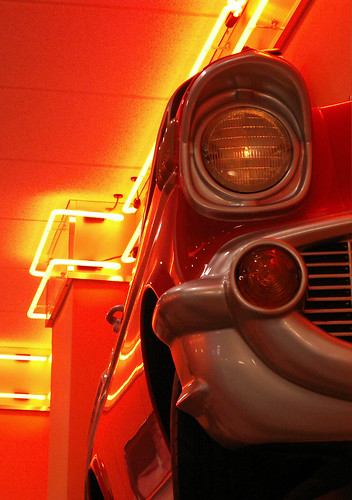POP! Goes The Mini Cooper Culture!
By: Mike Marino

The British Are Coming! The British Are Coming!
Those madcap ale drinking, pub hopping bloody Brit Redcoats ain't just figments of the imagination Mate! Nor are they strangers in a strange land to the landscape of American history. Over 200 years ago, a perplexed Paul Revere rode deep into the bosom of the dark of the midnight countryside to warn of imminent peril and invasion by the forces of King George, by George!
In due time, another George, ours, who went by the name of Washington, took careful aim for the royal jewells, gave them a swift kick in the royal cahones, and sent them packing north to Canada, eh, and back across the big pond to Jolly Olde England. The Americans, now victorious in revolution, would not fear nor suffer another British Invasion ever again...well, that is until the British Invasion of Mods, Rockers and Pop Culture hit our shores like a behemoth tidal wave with a rock n' roll backbeat in the 1960's!
Yeah, Yeah, Yeah!

The Fab Four...The Rolling Stones...The Who! Who? British Music and moptop haircuts sucker punched American youth culture with powerful pop culture blitzkrieg and brought it to it's sociological knees with a style of dress and a new code of conduct that would propel us into a whole new universe. A pop universe of James Bond, shaken, not stirred. Carnaby Street and Mary Quant, Dusty Springfield, Mods Aplenty and Pussy Galore. We were high on hiked up mile high mini-skirts and jazzed on jacked up go-go bootsl. Our hearts pumping in overdive, and without question, London proved, once and for all, that indeed, England swings like a pendulum do!
John, Paul, George, and Ringo, the Four Horsemen of the Beatles Apocalypse, made an indelible impression on all of us, similar to a tire iron being raked across the skull of some hapless victim in a dark alley in Detroit. However, it was an unlikely little motoring machine that not only came to personify that era more than anything else, but also flexed t's design muscle and became a major bonafide pop icon. A chrome-magnon pop star in it's own right with a cult following to match that of the Grateful Dead. That major, was a mini. A Morris Mini to be exact.
The red-dread, dread-of-Red ideological ice age that defined the meltdown nuclear Cold War era had produced a politicaly unstable behemoth of a glacier that was advancing and laying waste to everything in it's path. That same instability would eventually knock stability off it's pedestal and produce a plethora of petrol panic at the gas pump. The growing, out of control crisis in the Suez Canal region in the later part of the decade was to become the bravo-British-bravado version of the shootout at the OK Corral in the American Wild Child Wild West. This time those madcap Earp's and Clanton's were replaced by mysterioso shrouded-in-mystery Egyptians and pip-pip-cheerio stiff upper lip and all that Brits. Plain and simple, the sixshooter of oil consumerism had run out of bullets, and gas rationing, once again, was becoming a British way of life.
Clearly, a petrol saving, more miles to the gallon messiah of a car was needed to meet this crisis headon and to preach the gasoline gospel, and it was the vehicular virgin birth of a BMC classic that rose to the challenge. In 1952, two separate motor companies, Austin and Morris, merged in a marriage of metal to form the British Motor Corporation. BMC raced to meet the design needs of the growing gas crisis, and by 1958 had test driven and sent to production the design that would come to symbolize British Culture in the 1960's.
The underwraps mini wonder wagon was unleashed in 1959 in two separate versions. The Austin factory in Longbridge gave birth to the Austin Seven, "The Incredible Austin", while the Morris plant in Cowley delivered the Morris Mini, "Wizardry on Wheels". Both destined to evolve into the singular, all powerful and rally race fashionable Mini-Cooper by 1961.
Power and muscle were not hallmarks of the original design under the motor meister, Sir Alec Issigonis. Born in Turkey in 1906, Issigonis went to work at Morris Motors in 1936 after studying engineering in his new adopted homeland, England. His idea was simply to design a car that was safe for the public and affordable for the masses, following in the footsteps of the vehicular visionary, King Henry the Ford, and his immensly popular Model T, and also the popular German Volkswagen. According to legend, the original sketch of the Mini design was drawn on a restaurant table cloth.
The Mini, at first was merely a "housewifes car" fit only for toodling to the grocery or scooting about town. In 1961 it got a high performance injection of John Cooper vroom and zoom, and it was, not only off to the races, but also well on it's way to becoming the fashion accessory of the decade! The Mini sold a respectible 20,000 units in 1959 B. C. (Before Cooper), but by mid decade in 1965 it had topped the 1,000,000 mark milestone for units sold! Rolls Royce? Forgettaboutit! Sure the rich and famous owned one or two of them but the prestige piston pumper of choice by a veritable who's who was the delightful Mini. Peter Sellers had a wicker side paneled model the Pink Panther would have been proud of, and Ringo Starr had a hatchback Mini. Imagine! John Lennon owned one, as did George Harrison. Harrison was a huge fan of racing and rally events and his Cooper had a psychedelic paint job resembling a lava lamp on wheels that was also featured in the film "Magical Mystery Tour". According to an early interview with Harrison, he and Lennon took their first acid trip and drove around London in Georges Mini! Monkee Michael Nesmith drove his Mini to Clarksville and even the King of Cool, Steve McQueen motored in a Mini. On the dark side of the Mini moon, it was Marc Bolan of T-Rex Bang a Gong fame who crashed into a tree in 1977 in his purple Mini killing him instantly in West London.

John Cooper had a formidable background in high performance motoring. Born in 1923, John and Cooper, Sr. formed the Cooper Car Company in the aftermath and shadow of WWII, and by 1948 were building serious rear engine racing monster mo-sheens. The 1950's were the definitive age of the Chrome-magon. Racing was taking the world by the short hairs, and Cooper & Co. were making machines that were leading the perfomance pack on the racing circuit and in short time made it the must have car of the speed loving motoring public. John had already made a high octane impact on the autoworld, but the heavy metal planets were all in perfect alignment, and the best was yet to come when he put his expertise to work on the marvelous Mini. It was from this fornication of form and design that the pre-eminent rally sportser of the times would emerge...The Psychedelic Petroleum Prince of the Proletariat...The Legendary Mini Cooper!
The decade of the 1960's saw the super duper Cooper take on and kick asphalt in a variety of key races that proved her metal once and for all. The Mini Cooper won consecutive Monte Carlo Rally's, the Tulip Rally's in '62 and '64, the Alpine Rally in '63 and 25 other prestigious races out and about the European continent. The original Cooper's came with a 4 speed tranny, go from 0-60 in 12.9 seconds, 0-100 in 20 seconds and best of all, got an amazing 30 MPG! Racing Coopers however, along with the pedigree led a hard life on the circuit and many had to be reshelled continually.
The Cooper also had a low center of gravity for cornering, and the Cooper S of 1963 - 1967 had wider wheels than a stock Cooper. The Rally Rear Package came with straight through exhaust, mini lite wheels, roll bar, twin fuel tanks and a lightweight stick on lisence plate. Other inclusions where woodrim moto-lita steering wheel, Halda trip meter, tachometer, stop watches, map light and a fire extinguisher!
Mods needed rods and that damn little Cooper fit the bill and soon anyone who was anyone was sporting a Mini Cooper, from The Beatles to Peter Sellers. Michael Caine even drove one into the realm of fame and infamy in the film "The Italian Job" in 1969. The Mini Cooper was king, and as anyone knows, it's good to be the King!
As the Psychedelic Sixties began to fade away in a bag of seeds and stems, there were efforts afoot (Gadzooks!) to kill the little Mini beastie, but it kept selling in spite of those efforts. Cries of "It's Alive" could still be heard loud and clear at the car dealerships and showrooms, as the resiliant little creature refused to go down without a fight. Until the '80s.
As the decade of "Me" dawned on the horizon the Mini began to decline into it's own sunset on the automotive horizon, but a new company that was now producing the Mini was trying to keep itself afloat on the horsepower ocean and not sink like the ill-fated Titantic. That company, Rover, came out with themed editons to tap into the reigning motherlode of nostalgia and by 1990 Japan was eating them up like Godzilla beast-feasting on nuclear power plants!
Sir Alec passed on to piston paradise in 1988 and John Cooper crossed the quarter mile into horsepower heaven in the year 2000 at the age of 77. In 1994, Rover was acquired by BMW and today they produce and export three different models to the motoring masses. It might be a Mini but you can't judge a book by it's cover...the Mini Cooper Slogan sums it up best...
"You Don't Need A Big One To Be Happy!"



Classic Cars, Rock n' Roll, Elvis, Drivein Movies & Route 66! Kerouac, The Beats, Haight Ashbury, Easy Rider & Vietnam!

The Roadhead Chronicles goes from the Cold War Fifties Pop Culture of classic cars and rock n' roll to the spaced out Spare Change Sixties of Vietnam and Hells Angels. Not the usual look at the era, instead It's written by someone who lived it and spent a life of being on the road from his beach bum days in Honolulu to the glitz and dangers of the Sunset Strip in LA, and his purple hazed and double dazed days in North Beach and the Haight Ashbury in San Francisco. The Roadhead Chronicles also looks at the history of Route 66, Roadside Neon Culture and old diners and dives!

Mike Marino writes in an offbeat and irreverant style with a beat and a cadence that is all his own. His writing style has been compared to John Dos Passos, John Steinbeck and Terry Southern and one reviewer likened him to Frederick Lewis Allen on acid! Readers and critics call the book "wickedly wonderful", "delightfully weird" and "automotively sexy."!!
